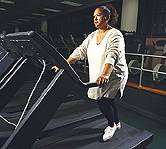
THURSDAY, May 23 (HealthDay News) — Statins are proven drugs taken by millions to lower their cholesterol, but the medications also could hamper heart patients’ ability to improve their cardiovascular health through exercise, researchers say.
A small group of overweight or obese people were unable to make any significant fitness gains while taking a 40 milligram daily dose of simvastatin, while another group not on the drug but undergoing the same exercise regimen did show improvement, found the study released online in advance of print publication in the Journal of the American College of Cardiology.
“If you exercise a group of people, they are going to have an increase in their fitness,” said study author John Thyfault, an associate professor at the Clinical Research Center in the University of Missouri School of Medicine. “In our group who was only taking statins, the improvements were blocked or did not occur.”
This finding could drastically affect the way physicians treat heart patients, particularly if it is found that other types of statin medications have the same negative effect on exercise benefits, Thyfault said.
People at risk for heart disease or metabolic syndrome (a cluster of factors that raise the risk for coronary artery disease, stroke and diabetes) often are prescribed statins to lower their blood cholesterol and at the same time advised to exercise more, he said. Both statins and exercise have been independently proven to lower cardiovascular disease risk, but may not pair well.
“Statins have saved lives, but I think physicians need to be careful about who they prescribe to, that it should be reserved for the most at-risk patients,” Thyfault said. “We need to rethink it. Not like a lot of people used to say, that statins should be put in the water supply.”
In the study, 19 people at risk for cardiovascular disease were placed on a 12-week exercise regimen in which they walked or jogged on a treadmill for 45 minutes, five days a week. Another 18 people were placed on the same exercise regimen but also were prescribed a daily dose of simvastatin, sold commercially under the brand name Zocor.
The people assigned exercise alone ended up experiencing a 10 percent improvement in their cardiorespiratory fitness, while those taking simvastatin only enjoyed a 1.5 percent increase in fitness, the researchers found.
Additionally, people in the exercise-only group experienced a 13 percent increase in “skeletal muscle mitochondrial content,” meaning that their muscle cells became more efficient in converting glucose and oxygen into energy. People taking simvastatin had a 4.5 percent decrease — their muscles actually became less capable of using energy.
At the same time, the drug did help reduce cholesterol for those taking it. Total cholesterol decreased by 29 percent and “bad” LDL cholesterol decreased by 38 percent in the exercise-plus-statin group, while there were no significant changes in total cholesterol or LDL in the exercise-only group.
This study should prompt more research into whether other types of statins have the same effect and whether a lighter dosage would make a difference, said Dr. Robert Eckel, a professor of medicine at the University of Colorado School of Medicine and past president of the American Heart Association. He was not involved with the study.
“I’m not totally surprised by this. The idea of exercise and statins and the interactions between the two of them has been known for some time,” Eckel said. “The new wrinkle here is the idea that fitness is modified in terms of the training effect.”
Eckel said it is also very likely that other statins will have the same effect, given that they all work in much the same way.
At the same time, it is too soon for heart patients to toss away their medication in favor of exercise, he continued.
“It’s hard to refute a large amount of data that supports the benefit of statins in preventing heart disease,” Eckel said. “And in general, a healthy lifestyle, you can’t leave that on the shelf and say if you’re on a statin don’t bother trying to work out. At this time, I would not tell a patient to remain physically inactive, but it does raise a question that needs to be further researched.”
More information
Visit the American Heart Association for advice on exercise and heart health.

